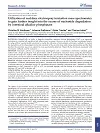RATIONALE
Related with its ability to degrade nucleotides, intestinal alkaline phosphatase (iAP) is an important participant in intestinal pH regulation and inflammatory processes. However, its activity has been investigated mainly by using artificial non-nucleotide substrates to enable the utilization of conventional colorimetric methods. To capture the degradation of the physiological nucleotide substrate of the enzyme along with arising intermediates and the final product, the enzymatic assay was adapted to mass spectrometric detection. Therewith, the drawbacks associated with colorimetric methods could be overcome.
METHODS
Enzymatic activity was comparatively investigated with a conventional colorimetric malachite green method and a single quadrupole mass spectrometer with an electrospray ionization source using the physiological nucleotide substrates ATP, ADP or AMP and three different pH-values in either methodological approach. By this means the enzymatic activity was assessed on the one hand by detecting the phosphate release spectrometrically at defined time points of enzymatic reaction or on the other by continuous monitoring with mass spectrometric detection.
RESULTS
Adaption of the enzymatic assay to mass spectrometric detection disclosed the entire course of all reaction components – substrate, intermediates and product – resulting from the degradation of substrate, thereby pointing out a stepwise removal of phosphate groups. By calculating enzymatic substrate conversion rates a distinctively slower degradation of AMP compared to ADP or ATP was revealed together with the finding of a substrate competition between ATP and ADP at alkaline pH.
CONCLUSIONS
The comparison of colorimetric and mass spectrometric methods to elucidate enzyme kinetics and specificity clearly underlines the advantages of mass spectrometric detection for the investigation of complex multi-component enzymatic assays. The entire course of enzymatic substrate degradation was revealed with different nucleotide substrates, thus allowing a specific monitoring of intestinal alkaline phosphatase activity.
